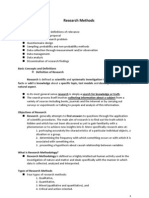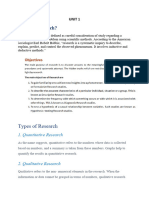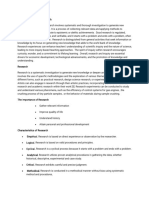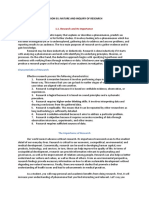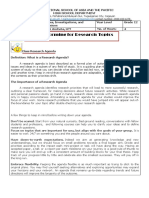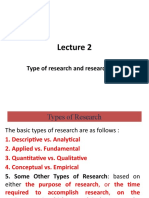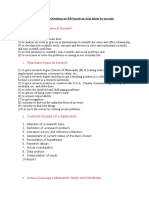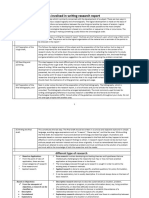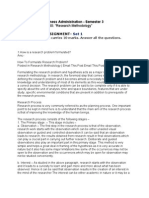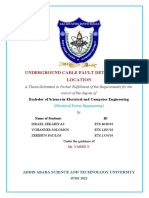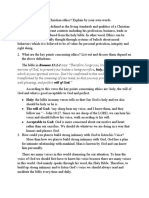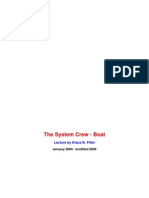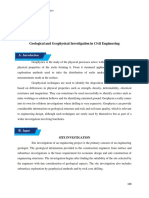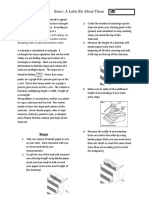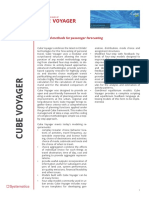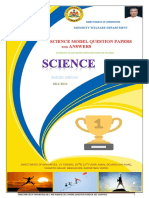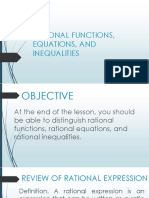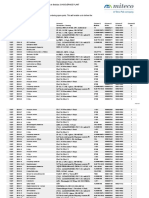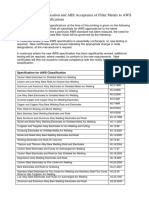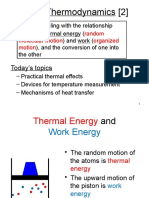2.
Research is classified in various categories including applicability, the mode of enquiry in
conducting the study, and major objectives of the study.
1. Basic research: is pure or fundamental research; there is no immediate need, but new theories
can be added to the knowledge cluster.
2. Applied research: tries to solve an immediate specific problem faced by industry or society.
3. Descriptive research: is generally used in business analysis or social problems. It just tries to
represent or analyze the previous and or current facts.
4. Analytical research: uses existing information to explain a complex phenomenon or to perform
a critical evaluation. The identified hypothesis can be accepted or rejected depending on the
analysis; from experience the hypothesis can be redefined.
5. Correlational research: focuses on exploring the relationship or association between
incidences, variables, and so on.
6. Qualitative research: mainly deals with the quality or the types of the parameters considered for
the research. Here, it is assumed that the world is unstable and differences in the parameter may
occur with time.
7. Quantitative research: involves measurements of quantities of characteristics that can be used
as features for the research study. Unlike qualitative research quantitative research assumes that
world is stable and uses statistical analysis on parameter values for conclusion.
8. Experimental research: focuses on the fieldwork and experiments that can control the
independent variable.
9. Explanatory research: tries to analyze and justify the reason behind the occurrence of particular
phenomenon or association between the variables.
10. Exploratory Research: generally explores the areas that have required meagre attention or it is for
checking the possibility of research in the particular domain or area.
3. Efficient and well-planned activities always see success. Therefore, one need to efficiently
plan a research activity, execute it meticulously, and publish it for outside world.
�1. Selection of domain/area of research: is the very first step in the process of research. There are
different purposes behind undertaking particular research. If it is getting the degree, there is a
high possibility to select the domain of the research guide or the guide may suggest selection of
the particular domain.
2. Formulating a Research Problem (Tentative) and Identification of Keywords: For an in-
depth literature survey researcher has to first define tentative research problem definition and
identify the related keywords for literature search.
3. The literature survey: is a comprehensive study of technical and authorized content related to
research keywords. It is very important step in the initial phase of research, however, this step is
� revisited by researcher number of times during research journey. Literature survey provide
details of research progress of particular domain.
4. Redefining Research Problem, Objectives (Final) and Outcomes/Formulating Hypothesis:
Problem definitions should be unambiguous, clear statement that states the major objective of the
research. There should be generally three to six sub objectives defined for research work.
5. Research Proposal: Researchers should able to convince people for selected topic and
objectives through the research proposal. It is very important document that is reviewed by
different committees. In industry proposal needs to be written for approval of top management,
finance and marketing department.
6. Identifying Variable/Parameters and Research Design: The variable is basic quality or
attribute that differs in value under different circumstances. The researcher should identify all
related variables or parameters. Parameters can be identified during literature survey and it may
vary depending on the proposed hypothesis.
7. Data Collection and Representation: Data can be either directly collected afresh known as
primary data or already collected and used data is known as secondary data. Secondary data is
already considered by researchers to test the hypothesis. Most of the times in experimental
research data is collected afresh to test the methodologies, hypothesis or algorithms.
8. Testing of Proposed Design on collected data/Hypothesis Testing: Researcher defines the
hypothesis and he/she needs to test that hypothesis to prove or disprove. This section focus on
hypothesis testing. Hypothesis testing is expressed as either a null hypothesis or alternative
hypothesis.
9. Results and Analysis: The result is an important section of the research. If the topic is totally
new then one cannot compare his/her results with existing. Here, the hypothesis should be tested
with multiple approaches and that results can be compared. If already some scientists worked on
methodologies or the topic it is important to compare your results with the existing state of the
art results from the literature.
10. Research Report Writing: There are different purposes for writing the research report. The
research report is a medium to convey research outcomes, contributions, findings and results to
the outside world. It decides the quality of your research work. Without approval of experts in
�domain, the research is incomplete. Publication of research in open, referred international journal
is very important aspect of the research.
7. Research proposal formats generally include the following sections: Introduction (Proposed
Topic of Research/Rational and Significance of the Study), Literature Survey (Background of the
Proposed Research/Study of Research Work Done in the Area and Need for More Research),
Motivation, Research Statement, Objectives of the Research Proposed, Probable
Methodologies/Techniques to be Used, Expected Outcome(s) (the kinds of conclusions expected
and their possible value), Plan of Research Work, References/Bibliography.
Research proposal is mandatory document to be submitted to the university or research
organization during the registration for a PhD degree. It can also be written to avail the funding
from different agencies. Every agency generally has its own research proposal format.




